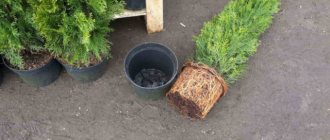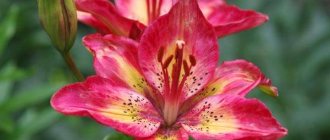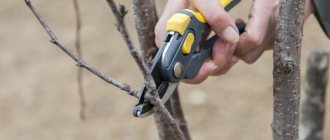Is it possible to replant hydrangea?
This shrub tolerates replanting without problems, but only if the replanting is done competently and carefully, taking into account the plant’s location requirements, water and light needs. When digging up an adult bush, if possible, try to preserve the soil ball in which the roots are located. A hydrangea that was previously grown in a pot will take root best in a new place, since its root system is not disturbed.
When is the best time to transplant a hydrangea to another location?
When carrying out the procedure, you need to remember that climatic conditions differ from each other in different geographical latitudes. As a result, the time for work will shift in one direction or another. The timing of planting hydrangeas in Central Russia is unlikely to be suitable for Ural parks. The reason is the difference in temperature between different seasons of the year, as well as their duration. For example, the Siberian spring is fast, hot and impetuous, while in the Moscow region it is leisurely, smooth, lasting from 2 to 3 months.
Did you know? Huge hydrangea inflorescences are located at the tips of the shoots and consist of several hundred small flowers with 4
–
5 petals.
In outskirts of Moscow
Quite often, winters in the Moscow region are very severe, when the air temperature drops to -15...-20°C. But this is compensated by long periods of spring and autumn, as well as summers with moderate heat and heavy rainfall. Thanks to such climatic conditions, gardeners can replant any variety of hydrangea both at the beginning and at the end of the warm season . It is advisable to build a winter shelter over the transplanted plant at the end of November or beginning of December.
When a hydrangea variety that cannot be pruned during the current period has been replanted, it is recommended to insulate its above-ground part for the winter. If this is not done, the fruit buds may suffer from low temperatures, as a result of which the bush will bloom only after a year. To protect against the cold, you can use white lutrasil, spunbond or other non-woven material. When purchasing, it is recommended to choose thick agrofibre, with a fiber density of at least 30.0 g/1 m².
Did you know? To give the snow-white inflorescences of garden hydrangea a blue or blue color, it is worth adding acid to the soil. To do this, the ground in the tree trunk circle is watered with water with the addition of ammonium sulfate or potassium sulfate.
In the Urals and Siberia
In cold areas of the country, it is recommended to replant hydrangea at the beginning of the warm season. In the region of Siberia or the Urals, the shrub will then have time to grow new roots in about 4–6 months. The gardener should take into account that cold weather sets in early in this area, and the first night frosts may occur as early as late August or early September. This means that work on transplanting a heat-loving crop must be carried out no later than the first ten days of May. It is optimal if at that moment the soil thaws two shovels deep.
In the Far East
In this region, the climate is much milder than in northern Siberia, but the winter is just as long and frosty, and the spring is stormy and short, quickly turning into summer. Here, spring replanting is also preferable, allowing the hydrangea to adapt and grow before winter. If there is still a need to do this work later, then it is better to choose the end of summer: the second half of August or the first ten days of September.
In this case, it is recommended to make heavy pruning at ground level, despite the variety of hydrangea, and warmly cover the surface of the soil under which the root ball is located. Warming is carried out with the onset of stable sub-zero temperatures. In the Far East, this period occurs around the beginning or middle of October.
Important! The gardener should not cover the hydrangea for the winter too early, as this can lead to the formation of fungus and mold on the above-ground parts, as well as rotting of the roots. It is best to carry out insulation work when the average daily temperature drops below -10°C.
Advantages of autumn transplantation
Hydrangea is a beautiful bush with large multi-colored inflorescences that delight the gardener every year. In order for this plant to live longer and be abundantly covered with flowers, it is advised to change its place of growth every 10 years. The first transplant is performed 5-6 years after planting in the ground. The best time to replant hydrangea is considered to be autumn.
In summer, during the period of greatest flowering activity, changing the location can have a bad effect on the health of the plant.
Adult hydrangeas are transferred in autumn or spring, when processes inside the branches are somewhat slower.
Advantages of autumn transplantation compared to spring:
- It is better to replant on time (from late August to early October). September is the ideal time to move bushes into the garden. The root system of the plant will have time to adapt and prepare for winter. And in the spring it will be ready for the first flowering.
- At the beginning of autumn, the soil is still quite warm. When the rains begin, you need to water your hydrangea regularly. A gradual decrease in temperature will not provoke the emergence of new young shoots that will be destroyed by frost.
- Autumn replanting goes well with its planned pruning. When performing such work, you can also propagate the plant by cuttings or division. In the spring, the transfer is limited by various unpleasant consequences if the gardener tries to carry out additional manipulations.
When is it better to replant hydrangea: in spring or autumn, is it possible in summer?
Hydrangeas are quite demanding, so when transplanting them to another area, you should follow agronomic recommendations so that the bushes take root well and bloom profusely in the future. The best time of year for planting this perennial crop is early spring (from March to April inclusive), since there are long summers and autumns ahead, which means that the plants will have time to acclimatize after the procedure before severe frosts arrive.
It is also permissible to plant shrubs in the fall ( from the second half of September to the end of October), but in this case the gardener needs to protect them well from the cold, since even frost-resistant species may not survive the first winter.
When can you replant an adult hydrangea?
In the summer, it is recommended not to replant plants , since hot weather, together with the shock from the disturbed roots, often leads to wilting and disease of the bush. Subsequently, the hydrangea may begin to grow, but this will be preceded by a long illness and adaptation. That is why the most successful period for such work is spring and autumn. These are the times of year when the air temperature remains moderate for a long time and rises or falls gradually.
Did you know? Even the ancient Greeks noticed the huge need for moisture in hydrangeas. This feature is reflected in the botanical name of the culture - hydrangea (hydrangea), consisting of the words “water” and “vessel”.
Care after landing
In order for a flower to take root well in the fall and become a real decoration of the garden the next season, it must be cared for throughout the adaptation period after replanting.
If the autumn is dry, you will definitely have to water the seedling once every 10 days. Stagnation of moisture should not be allowed, but according to the recommendations of experts, in dry weather one plant needs 20-30 liters of settled water. If precipitation naturally keeps the soil moist, then there is no need to further moisten it. No fertilizing is carried out during this period, since the nutrients that were added to the soil are quite sufficient. But loosening should be done once a week to avoid insufficient air penetration deep into the soil.
In the fall, with the onset of the first cold snaps, the earth around the trunk is mounded to a height of about 20 cm to enable the underground organs to better adapt.
How to properly transplant hydrangea to a new location
Gardeners have a rule: in the spring, it is recommended to move a plant with an open root system to another place before the buds swell and bloom. If the moment is missed, the transplant is postponed until autumn.
Before planting, you need to choose a suitable location; it should be protected from the north wind and be in partial shade. There are also requirements for the substrate in which the roots will be located: the soil must be fertile, humus, loose, permeable to water and oxygen, slightly moist, with a slightly acidic pH.
Important! If, after removing the bush from the pot, it turns out that the root ball is very compacted, then before planting the gardener should gently knead it with his hands, which will help the plant to soon form new roots.
Planting hydrangea:
- In the selected location, dig a hole in the soil. Its dimensions should be twice as large as the root ball of the seedling.
- A mixture of soil and acidic peat (15–30 cm) is placed at the bottom of the depression, after which the plant is placed on top at a depth corresponding to the one at which it has grown so far.
- If a bush that is already growing in an open space is moved to a new location, it should be carefully dug up so that as many roots as possible are preserved. This will reduce the shock associated with the move. It is more convenient to carry an adult plant together, so two people will be needed for this work.
- In the case when part of an old bush is replanted (during rejuvenation), then after removing it from the soil it is necessary to carefully examine the root system and remove the oldest, thickest or dead parts with pruning shears.
- Then the planting hole is filled to half with prepared soil, compacted well and watered abundantly. After the moisture is absorbed into the soil, the depression is filled with soil to the surface level.
- After planting, the soil around the bush should be carefully compacted, creating a small depression to retain water during watering in the root zone.
- Next, the tree trunk circle is mulched using crushed pine bark or large sawdust.
in autumn
During this season, work on replanting shrubs should be carried out as early as possible. A signal that the right time has come for such events is a decrease in average daily temperatures to +15...+18°C. Hydrangeas planted in the fall are usually not pruned so as not to weaken the bush before the long winter.
Video: Transplanting hydrangea in autumn
In order for disturbed plants to survive prolonged cold without loss, it is advisable to insulate them. To do this, a thick layer of mulch is laid in the tree trunk area, which will protect the roots from freezing, and the shoots are wrapped in 2-3 layers of agrofibre.
Find out why hydrangea doesn't grow well.
in spring
Bushes that were transplanted in early spring (from March to April) definitely need to remove the above-ground part. Pruning must be adapted to the requirements of the species because plants bud differently and improper pruning may prevent the gardener from blooming in the coming season.
How to prune different types of hydrangeas:
- On last year's shoots, garden, large-leaved, paniculate, tree-like and climbing hydrangeas form inflorescences, so in the spring you can very delicately cut off the last developed pair of buds, as well as remove diseased and damaged branches. If you prune the plant more, for example, to give it a more compact shape, flowering will not occur this season.
- Bouquet and shrub varieties form fruit buds on the branches of the current year, so after spring planting they can be heavily pruned. This procedure will have a beneficial effect on the overall development of the seedling; it will form many young shoots and bloom profusely in the summer.
In summer
Sometimes in the summer it is necessary to urgently replant a hydrangea from a pot. It happens that its volume has become small for the root system or the bush has begun to hurt. This can be done if the transshipment method is used, during which not a single root is harmed.
Important! To transplant hydrangeas using the transshipment method, choose a rainy or cloudy day. After the procedure, the plant is shaded using spunbond or lutrasil by 7
-
10 days.
Transplanting potted hydrangea in summer:
- Dig a wide and deep hole and fill the bottom with loose, acidic soil.
- The plant should not be watered under any circumstances.
- The walls of the container are tapped with the handle of a knife to separate the soil lump, after which it is carefully removed and placed in the prepared soil hole.
- Next, the side voids are filled with earth, the bush is watered using at least 5 liters of water, wait until the moisture is absorbed, and, if necessary, add substrate.
- Be sure to lay a mulch layer.
- The roots of a plant moved to another place in the summer must be constantly moist, so it must be watered frequently, pouring out 1.5–2 liters of water at least twice a week.
Recommendations for the procedure
To carry out a transplant correctly, it is first of all important to choose a location and select the appropriate soil . Another nuance that requires attention is the time of transplantation, which directly depends on the region of growth.
Selecting a location
When replanting hydrangeas, a very important point is choosing the location of the planting hole. The flower is very light-loving, so the place should be in as sunny a place as possible. If there is no such place on your site, then you can transplant the flower into partial shade.
Pit preparation
The hole should be 50*50*60cm in size - provided that one bush is replanted . If you plan to transplant several bushes at the same time, then the distance between plants should be 1.5 meters.
Soil mixture
The soil for replanting should be as light and loose as possible. If your substrate is heavy, you can add coarse sand to the mix. Loam with an acidic and neutral reaction is considered the most useful. Chernozem, soil saturated with lime, is absolutely not suitable for hydrangea. The color of the plant's flowers directly depends on the level of acidity.
Composition for soil mixture:
- peat – 1 part;
- humus - 2 parts;
- leaf soil - 2 parts;
- river sand – 1 part.
Fertilizer is added to the soil mixture:
- potassium sulphide 0.2 grams;
- superphosphate 0.6 grams;
- humus 0.1 grams;
- urea 0.2 grams.
Video about what soil mixture is needed for growing hydrangea:
Seedling preparation
Before replanting, it is important to prune the bush. Weak and frozen branches, as well as branches that are more than 3 years old, must be removed. Be sure to shorten all branches by 30%. This procedure is carried out so that the hydrangea undergoes transplantation as painlessly as possible and the inflorescences are formed as large and dense as possible.
How often can you replant?
It is not recommended to disturb the shrub too often, since even after a very successful and seemingly painless transplant, the plant experiences stress. This condition leads to long-term adaptation, during which it becomes ill and cannot develop its above-ground and underground parts normally. In the most unfortunate cases, this ends in the death of the hydrangea.
You will be interested to know how to preserve hydrangea in the winter in the garden and at home.
Given the negative consequences, transplantation is recommended only when necessary. For example, a tall tree has grown greatly next to the flowerbed and is shading everything around, or an old bush is overly thick with shoots and needs to be rejuvenated by dividing it.
Preparing for winter
In the first year after transplantation, all specimens need shelter, since they enter winter in a weakened state. Before the start of winter, pluck off all remaining leaves that may become damp and moldy under the covering material.
Before sheltering, a disinfecting treatment is carried out, which will stop the development of fungal diseases and parasite damage. To do this, young seedlings are generously sprayed with 1% Bordeaux mixture or a solution of the Abiga-Peak preparation. Not only the ground parts are cultivated, but also the tree trunk circle of the earth.
In the first year after transplantation, you can choose one of the following sheltering methods:
- Specimens up to 30 cm high. All branches are sprinkled with dry leaves or high peat, spruce branches are placed on top, and a film is spread over the spruce branches, which is fixed to the ground with stones or bricks. The film can be either transparent or opaque.
- Instances are 30-150 cm high. A metal frame made of fine-mesh mesh is installed around the plant, inside which foliage is poured, and lutrasil with a density of 30 units is placed on top.
- Large specimens are taller than one and a half meters. All shoots are tied with twine and wrapped on top in several layers of agrofibre, fixed with tape. A pyramidal frame is installed above the plant, the peak of which is 13-15 cm above the bush. The space between the frame and the flower is filled with dry leaves, and finally the entire structure is wrapped in roofing felt or film.
With such shelter, hydrangea can withstand frosts reaching -40°C in the first winter. It is possible not to carry out such thorough preparation in the fall only in the southern regions, where frosts do not fall below -5-7°C.
Is it possible to replant flowering hydrangea?
Experienced gardeners do not recommend disturbing the root system of flowering shrubs . Stress will certainly lead to the withering of inflorescences and the falling of blossoming buds. This applies equally to both indoor and outdoor hydrangeas of any variety. It is worth waiting not only for the end of flowering, but also for the onset of the appropriate period of the year.
Replanting shrubs is not a very difficult task for an experienced gardener. But it is worth considering that hydrangea is a very demanding plant, and replanting should only be done in the appropriate season, choosing the desired phase of crop development.











